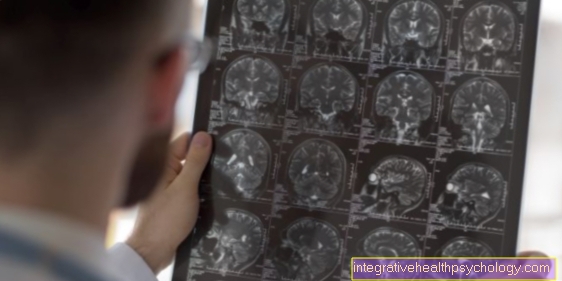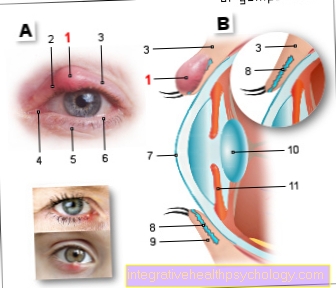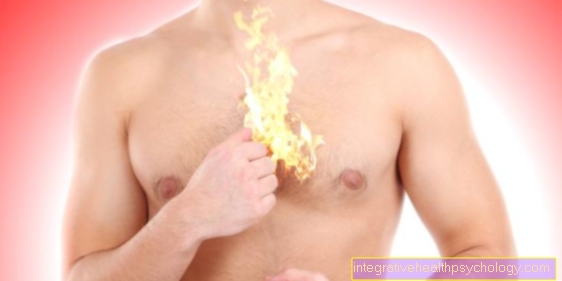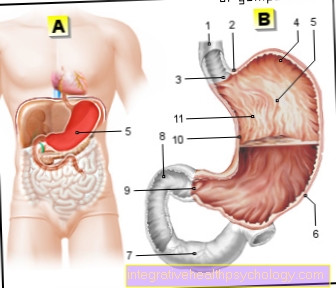Acute myeloid leukemia (AML)
Synonyms in a broader sense
Leukemia, white blood cancer, Auer rods, Blood disease
definition
This type of leukemia is one of the acute leukemias with a rapid disease course. It is characterized by the fact that the degenerated cells come from a very early stage of development, i.e. are immature. These cells arise from a row of cells that consist of the Bone marrow originates (myeloid). The cells in the early stages of development are called blasts. These blasts multiply in the bone marrow and blood.
.jpg)
Disturbed maturation
In the context of acute myeloid leukemia there is a uncontrolled reproduction of immature and functionless blood progenitor cells in the bone marrow.
In healthy people, there is a precise regulation and balance between emergence and maturation or differentiation into fully functional blood cells. In contrast, the AML maturation disturbed.
For some years now, the therapy of acute promyelocytic leukemia, a special form of AML, has made use of this fact. The chemotherapeutic ATRA promotes the maturation of the leukemia cells into functional blood cells.
frequency
There are three to four new cases per year for every 100,000 inhabitants. It is mainly adult patients who are affected by the disease, here the number of new cases is 15 per 100,000 inhabitants. The rate of AML Leukemia in children is around 20% of acute leukemias.
AML in children
Children get sick rather seldom on acute myeloid leukemia. Only about 20% of childhood leukemias fall into this subspecies. Acute lymphocytic leukemia (ALL) can be observed much more frequently in childhood.
In principle, AML can occur at any age, but babies and toddlers are particularly likely to get sick in the first two years of life. For as yet unexplained cause, boys get sick more often than girls. Children with Down syndrome (trisomy 21) have a significantly increased risk of the disease. As with adult patients, affected children develop the first, identical symptoms within a few weeks. Small children are occasionally noticed by their reluctance to play and lazy running. To confirm the diagnosis, the bone marrow puncture is performed under anesthesia. The main component of therapy is chemotherapy. If the central nervous system is affected, the skull may have to be irradiated.
causes
See general chapter on leukemia.
Disease emergence
Above all, irregularities (aberrations) in the human genome (chromosome set) were recorded as triggers of AML and the findings of the cell genetics are the most important factor for the prognosis of the patient.
There are aberrations with a good forecast and aberrations with a poor forecast. The uncontrolled, unchecked growth of the degenerate progenitor cells is so pronounced that other cells or progenitor cells in the bone marrow no longer have any space to develop. These "normal" cells are therefore displaced. This explains the common poverty of red blood cells (anemia) in AML patients. If more than 30% of the blasts are present in the bone marrow, then the definition of acute leukemia is given.
That could be interesting for you too: Chromosome mutation
Symptoms
There is increased night sweating, fever, Weight loss, loss of appetite, poor performance and bone pain. It also comes to Anemia (Anemia); the symptoms of which are paleness of the skin, decreased performance, Racing heart (Tachycardia) and rarely even chest tightness (Angina pectoris). The displacing growth of the degenerate cells leads to a lack of “normal” defense cells. The result is increased infections, such as of the lung (e.g. lung infection) or the renal pelvis (Pelvic inflammation). Patients get a fever more often. The poverty of platelets (Thrombocytopenia) It comes to increased bleeding, also after so-called minor trauma, e.g. in such everyday activities as brushing your teeth. The result are symptoms like Bleeding gums, Epistaxis and spitting blood. Symptoms such as enlarged gums (gingival hyperplasia) or double vision are rarely seen. The attending physician should likewise make an enlargement of the spleen and the liver (Hepatosplenomegaly).
So leukemia can be recognized by many different signs.
Read more on the topic: How do you recognize leukemia?
diagnosis
One of the first steps is to simply draw blood. This is used to determine the number of cells in blood platelets (thrombocytes), red blood cells (erythrocytes) and white blood cells (leukocytes). Since the group of leukocytes contains several different cell types (lymph cells, granulocytes), a so-called differential blood count is created, which gives a precise analysis of these cells. An absolute or relative decrease or increase in these cells is then recognized. In the case of AML, the above-mentioned investigations result e.g. a low number of red blood cells (anemia) and a high number of white blood cells (leukocytosis).
Read more on the topic: Bone marrow puncture
Microscopic examination
A blood or bone marrow sample can be analyzed using the microscope. If so-called Auer rods are found in the examined cells, then the AML is proven. These Auerbach sticks resemble the smallest sticks in the cell body.
Bone marrow aspiration
For analysis, a sample is taken, preferably from the basin. This sample is then colored (cytochemical staining) and further analyzed.In addition, the cells removed are examined for their genetics in order to detect irregularities (Aberrations) to be found in cell genetics (Cyto- and Molecular Genetics). The cytogenetic findings play a major role in the prognosis. A connection (translocation) between the gene carriers (chromosomes) 8 and 21 is to be assessed as positive for the prognosis, while the loss of chromosome 5 e.g. has a very bad prognosis.
therapy
Chemotherapy:
The aim of this therapy is to use growth-inhibiting substances to destroy the leukemia cells. The problem that arises here is that the substances act not only on leukemia cells, but also on all rapidly growing cells in the body, e.g. other blood-forming cells, hair cells (this is why the side effect of Hair loss at chemotherapy) and, particularly problematic, the germ cells (e.g. sperm cells).
Stem cell transplant:
There are two ways of doing this Stem cell donation: On the one hand, family members or external donors (allogeneic), if the tissue characteristics match, stem cells are removed and administered to the patient. "Normal" healthy blood cells are then formed from these stem cells. However, high-dose chemotherapy must be carried out beforehand in order to destroy all degenerated cells as far as possible (for the principle of high-dose chemotherapy, see general section on leukemia). On the other hand, the patient himself (autologous), if this is in the meantime in a stage of so-called full remission, i.e. When most of the degenerate cells have been destroyed, healthy stem cells are removed and given back to him when the disease returns. However, autologous stem cell transplantation is still in its infancy and is more likely to be used in clinical trials.
Special drugs:
The drug Gemtuzumab has shown very good results in the treatment of AML in recent years.
Care during chemotherapy
In the context of chemotherapy, those affected suffer from many strong side effects. In this situation, the best possible care is very important and can alleviate many side effects:
- Nausea and vomiting: Nausea and vomiting is one of the main problems of many AML patients under chemotherapy. In addition to medication, e.g. Aromatic oils, chewing gum or fresh room air provide relief.
- Prevent Infection
- During chemotherapy, the immune system is temporarily suppressed. Affected patients therefore have almost no endogenous defenses and are particularly susceptible to infection. Strict hygiene measures are therefore the be-all and end-all. Under certain circumstances, so-called "reverse isolation" of the patient may even have to be carried out. This means that clinic employees or relatives are only allowed to enter the hospital room in special protective clothing. The aim is to reduce the number of potentially dangerous bacteria, viruses or fungi.
Alternative treatment
It is not uncommon for those affected to seek alternative treatment for acute myeloid leukemia. Especially in the age of the Internet, a multitude of apparently “gentler”, “alternative” or “natural” therapies can be found quickly.
However, one can make this promise Give faith? No, under no circumstances. Chemotherapy only and Bone marrow transplant provide an adequate and promising therapy dar!
First and foremost, many sufferers turn to alternative "treatment offers" out of fear of the severe side effects of chemotherapy. However, since AML is very aggressive, the treatment has to be made correspondingly intensive and aggressive.
Allegedly “gentle” or “alternative” treatments are definitely not an option for serious medical professionals. In the worst case scenario, patients will die trying to undergo alternative treatments.
- Chemotherapy - How Does It Work?
- Chemotherapy side effects
What happens if there is no therapy / treatment?
Like all acute leukemia, AML is also through a very aggressive course of the disease marked. If left untreated, it leads to death within a few weeks. That is why it is extremely important after that faster diagnosis immediately after treatment is started.
If one decided against treatment, there would be a massive increase in leukemia cells within a very short time. Healthy blood cells would be largely displaced. Eventually, with the loss of healthy blood cells, there would be numerous, all potentially fatal symptoms. These include multiple organ failure, blood poisoning, vascular occlusions and internal bleeding.
Life expectancy / prognosis / chances of recovery
Unfortunately, it is not possible to make general statements about the chances of recovery. The prognosis varies and depends heavily on individual influencing factors. Have so following factors one rather negative influence on the forecast:
- Age> 60 years
- White blood cell count> 100,000 / microliter at the start of therapy
- Decreased response to therapy ("refractory to therapy")
- Increased chromosomal changes
Nevertheless, the presence of one or more of these "negative prognostic factors" does not automatically reduce the chances of recovery at AML. Concrete statements can therefore only be made by the attending physician.
It is also worth mentioning that the chances of recovery from AML have greatly improved over the past few decades.
This is primarily due to the so-called "therapy optimization studies". In Germany, almost all AML patients are im Framework of these clinical trials treated. This gives patients access to latest scientific knowledge and modern drugs. At the same time, “therapy optimization study” does not mean that the drugs used are experimental or in the trial phase. Instead, the goal is to find the best possible application areas, dosages or combinations of approved and proven chemotherapeutic agents. Participation in the studies is of course voluntary.
In Germany almost all clinics participate in therapy optimization studies in order to improve the prognosis of AML in the long term.





























